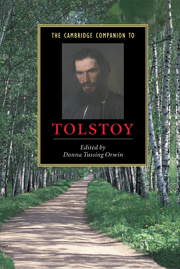Introduction
Published online by Cambridge University Press: 28 May 2006
Summary
Count Lev Nikolaevich Tolstoy, one of the world’s greatest novelists, came to fiction after toying with other vocations, and even after becoming a successful writer, he kept trying other things. In 1852 he entered the army and contemplated a military career. At various times in his life he paid more attention to agriculture, pedagogy, and various social reforms than he did to literature which, moreover, he more than once abandoned for more important activities. As he said proudly on one occasion, unlike Pushkin and Turgenev, he and the poet Lermontov were not literati. He regarded the motives of writers with suspicion and once declared that his brother Nikolai had been more talented as a writer than he but had lacked the requisite vices.
When Tolstoy referred (in late unfinished memoirs) to the vices necessary for becoming an author, he meant the desire to influence others and to be loved by them. Unlike his very private brother Nikolai, he felt this keenly. He told his wife that when he read a favorable review of Childhood while on a hunting trip in 1852, he choked back “tears of joy.” As he mentioned many times in his early diaries and drafts of early works, he regarded his reader as potentially a close friend. While this is a convention of sentimentalist prose, Tolstoy adopted it for personal as well as professional reasons. (Many critics associate his need for intimacy with the loss of his mother before he was three, and his father when he was nine.) Even in his old age, in 1890, he told a disciple (P. A. Sergeenko) that because he no longer cared for glory, in his drama The Light Shines in The Darkness he now wanted “to speak out my most sincere and intimate thoughts.”
- Type
- Chapter
- Information
- The Cambridge Companion to Tolstoy , pp. 49 - 62Publisher: Cambridge University PressPrint publication year: 2002
- 1
- Cited by



